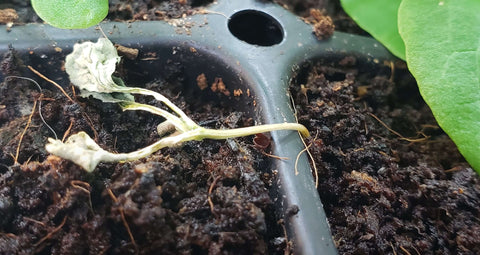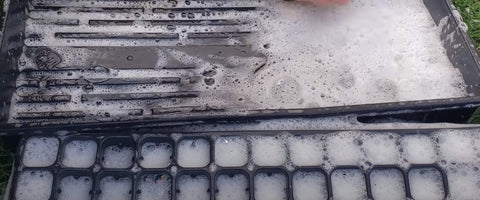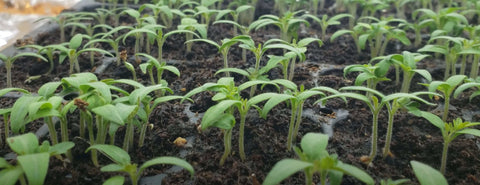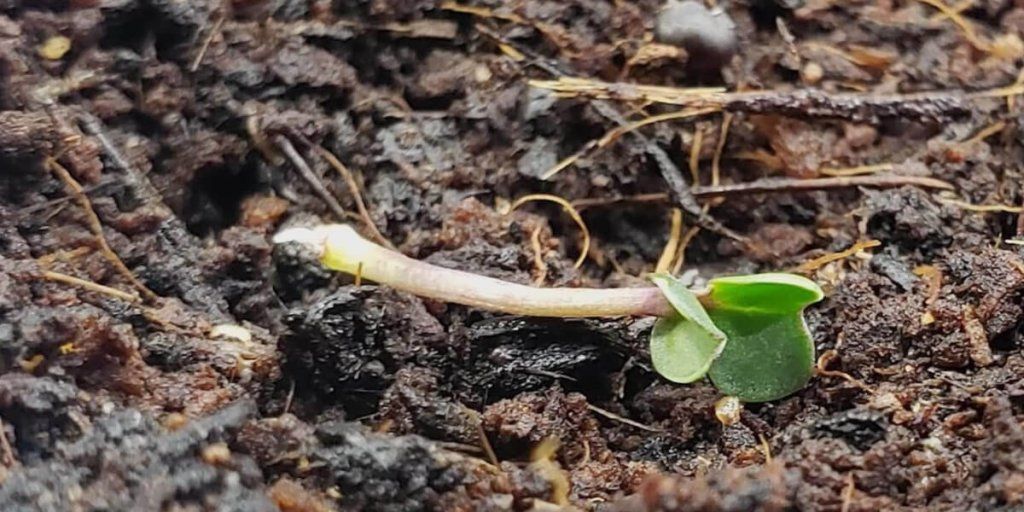Seedling of almost all fruit, vegetable, field and ornamental crops can get affected by damping off diseases. It is caused by a fungus or mould that thrives in cool, wet conditions. Damping off can kill young seedlings, causing them to rot at the roots or crown. You can do a few things to prevent damping off and protect your plants. In this blog post, we will discuss what damping off is, how to identify it, and how to prevent it from affecting your plants!
What is damping off, and what are the symptoms of this disease in plants?

When healthy seedlings turn up dead the next day, it is most likely due to damping off. It affects the stems of seedlings at both the soil line and above. Some seedlings may start to grow and suddenly wilt. Others will have stems that appear pinched or broken, causing them to collapse while they still have their cotyledons attached. You may also see leaves that turn yellow or brown, wilt and fall off. In severe cases, the entire plant may succumb to the disease. Damping off may be responsible for just about any poor germination. This disease is caused by various fungi, bacteria, and viruses, which can be challenging to prevent. Once inside the plant, these pathogens begin to attack the cells, causing the plant to collapse.
Two types of damping off
There are two types of damping-off. Pre-emergence damping-off kills seed or seedling sprouts before they emerge. This form of damping-off is triggered by a range of fungi, including Pythium spp., Rhizoctonia solani, and Fusarium spp. These fungi commonly enter the seed via openings in the seed coat or damaged coats. The fungus grows inside the seed, causing it to rot. The seeds will not germinate or produce weak, disease-prone saplings.
After seeds have sprouted from the ground, damping-off can still occur. This is often caused by fungi, such as Pythium spp., Rhizoctonia solani, and Fusarium spp. These fungi enter through holes or wounds in a plant's roots or stem. The infection then gradually moves up, causing the stem to rot. If the taproot or rootlets become soft and spongy, it will result in seedlings falling over; however, if the stems are more rigid (e.g. cabbages), they won't fall but will be thin, discoloured with possibly bent or broken twisted stems - thus named 'wire stem'. Eventually, the stems are girdled, and the plant dies.

Post-emergence damping off is even more dangerous because it can decimate full-grown plants. However, both types of damping-off can cause severe crop losses if not controlled.
Which conditions cause damping off?
While there is no single cause of damping off, several conditions can contribute to the problem. Damping off is most likely to occur in spring, when conditions are cool and moist, making it an ideal environment for fungal growth. Additionally, it is usually the result of too much water or too little air. If seedlings are kept too moist, the soil will become waterlogged and unable to provide the roots with enough oxygen. This can cause the seeds to rot before they have a chance to germinate. Too little air circulation can also dampen off, as stagnant air is a breeding ground for fungal spores. Planting in soil too rich in nitrogen can also encourage the development of damping off, as the excess nutrients encourage rapid growth, weakening the seedlings' ability to withstand stress.
Several different fungi can cause damping off, including Pythium and Rhizoctonia. In many cases, multiple fungi will be present, making it challenging to identify the exact cause of the problem.
How does damping-off spread?
Once the fungi have taken hold, they quickly spread, attacking the roots of plants and seedlings. This pathogen is soil or water-borne and rarely spreads through the air.
Rain, irrigation, water splash, and contaminated tools can all play a role in disease transmission. The transmission mode is different for different pathogen species, but the common mode of spread is through infected soil or potting mix, as can infected plants. In many cases, diseases can be spread by all of these methods. In addition to causing significant damage to your plants, damping off can also make your garden unsightly. Infected plants will often turn brown and wilt, spoiling the appearance of your garden.
What are some organic methods for controlling damping-off fungus in the garden?
You can take several steps to prevent damping off from affecting your plants and create an environment that is hostile to fungal growth and conducive to vigorous, healthy seedlings.
First, ensuring that your seed-raising area or garden is well-ventilated is essential. A small fan or simply cracking the lid of the germination tray will suffice.
Second, you should avoid overwatering your plants, as this creates the perfect environment for fungus to thrive. One way to reduce the risk of damping off is to plant in well-drained soil and to water only in the morning, so the leaves have time to dry before nightfall. Water the plants at the base, rather than from above, to reduce the amount of moisture the leaves and stems are exposed to.
Third, avoid using tools that have been in contact with diseased plants on healthy plants.
Fourth, crop rotation can also help control damping-off fungus.
Fifth, practice good hygiene in your garden. This means keeping tools and equipment clean and washing your hands thoroughly after handling them. Removing any dead or dying plants from your garden as soon as possible is essential, as they can serve as a breeding ground for disease.

Sixth, be sure to choose disease-resistant varieties of plants whenever possible.
Finally, you should consider using a sterile potting mix and clean containers when planting new seeds or transplanting seedlings.
All of the above are organic methods for controlling the damping-off disease.
What about chemical treatments?
One common issue that fungicide-treated seeds help to prevent is damping off, which is caused by fungi that attack young seedlings. Even though they are not the prefered choice for organic or most home gardeners, they can offer this benefit. In addition, fungicide treatments can help to prevent seed or soil-borne diseases & other diseases such as blackleg and root rot.
Commercial farmers commonly use fungicide-treated seeds to prevent seedlings from contracting diseases, such as damping off. Thiram is a fungicide that is commonly used in seed treatments. It is effective in preventing diseases, but it can also be harmful to humans and animals if ingested. For this reason, it is essential to read the label carefully and take precautions when handling fungicide-treated seeds. Wear gloves and wash your hands thoroughly after handling the seeds. Keep the seeds out of reach of children and pets. Do not eat or feed treated seeds to humans or animals.
While fungicide-treated seeds are not the ideal choice for every gardener, they can be a helpful tool in combating damping-off and various plant diseases.
How to cure damping-off?
The only treatment is prevention. It is extremely difficult to cure damping off once the disease is advanced. It also spreads rapidly and may require culling if it cannot be prevented in time. Fungus spores can linger in soil and compost. It can also be spread to nearby plants.
Chemical treatments are also available but should be used as a last resort. These include fungicides such as thiram, chlorothalonil or mancozeb. However, it is essential to note that these chemicals can harm people and animals if not used according to label directions, so they should be used cautiously.
What should you do if your plants have been affected by damping off?
If you do notice signs of damping off, it's crucial to take action immediately. Remove any affected plants and dispose to prevent the disease from spreading.
How to dispose of infected plants safely?
If you suspect a plant in your garden is infected with a disease, it is vital to take action quickly to prevent it from spreading. However, it is also essential to dispose of the plant carefully to avoid contaminating other plants. The best way to dispose of an infected plant is to dig it up, roots and all. If the plant is too large to dig up, you can cut it down, but be sure to disinfect your pruning tools afterwards. Once the plant has been removed, it should be placed in a sealed plastic bag and in the trash. Do not place them in the compost, as the pathogens can linger in the soil. It is also a good idea to remove any mulch or compost that was in contact with the plant, as this may also be contaminated. Then, sterilize your pots and growing tools with a solution of one part bleach to ten parts water.
Further note:
Damping off is a common problem for young plants, but older plants are much less likely to be killed by it. This is because secondary stem tissue produces a barrier that limits fungal penetration.
We hope that this topic has assisted you in learning more about damping off and how to avoid it.



6 comments
Mike
Thank you for this valuable info as I now know how to identify damping off and steps to mitigate it from occurring and spreading.
Priscilla
Thank you very much I’m a new Gardener as well learning a lot this is new to me thanks so much God bless you
Osborne Jannette
Thanks for the information was very helpful. God bless
Jeffrey Empson
Thank you for the information regards damping off. As an inexperienced gardener I was unaware of this problem. I have had such problems and can now take preventative measures.
Thanks. Jeff.
Ralph
Thanks, this is a really helpful article.
B.Cooper
Excellent information – thank you.